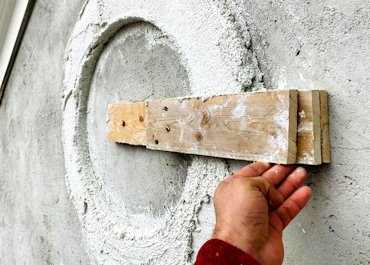REAL Stucco
in Alexandria, Virginia
Here's how we did it:

Work by the competition was torn off and re-done. One coat stucco with a synthetic finish was completely unappropriate
on this historic 1804 house. Check out the metal control joint. These weren't invented until the 1950's.

We cut the two by four off under the window to allow room for an angled sill. Note the water streaks. This stucco was 9 months old. It was done by a company that does big houses in McLean and Great Falls.

The competition used flat lath instead of self-furring. Wall had a thin basecoat and was covered with EIFS cloth and EIFS basecoat, for some strange reason. A cornerbead made for interior use was used.

Wall was brought down tight to the slab and even sealed with caulk, trapping water that should drain out of the wall.

Weeps are used at the bottom of the wall to allow any water that penetrates the stucco to exit.

Peel and stick rubber and aluminum flashing was tucked under the window jamb.

Protecto wrap overlaps flashing at the bottom.

Sides and top of window are sealed with protecto wrap.

We made flashing to put on horizontal trim boards. It had no flashing before.

We put on two layers of tar paper.

Self furring metal lath. Note we covered the windows with correx, corrugated plastic sheets before tearing off the one coat stucco.

Walls are straightened by setting wood strips with a string line.

Walls are filled and rodded off between the wood strips.

Window returns are done by nailing one by fours on the outside and filling in.

Window surrounds are formed and filled with metal lath and white portland cement and sand. The foam is only temporary. Here, we are putting in stub nails using a magnet.

This style of window sill was popular in the 1800's. I took this picture nearby.

Sills are formed and filled with white portland and white sand.

The finished surrounds and sills have an authentic historic appearance. Sills have a steep angle for good water run off.

Round window was run using a swing arm.

Finished ring.

The sand for the finish coat is crushed quartz from US Silica.

Color is yellow oxide paint colorant mixed in a garbage can.

Finished.

Finished addition.
























